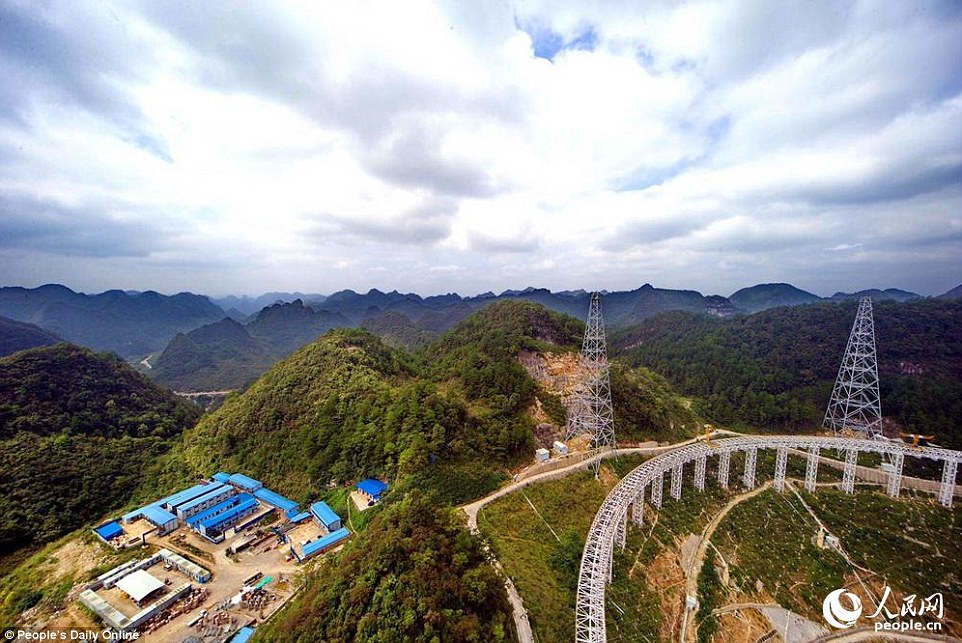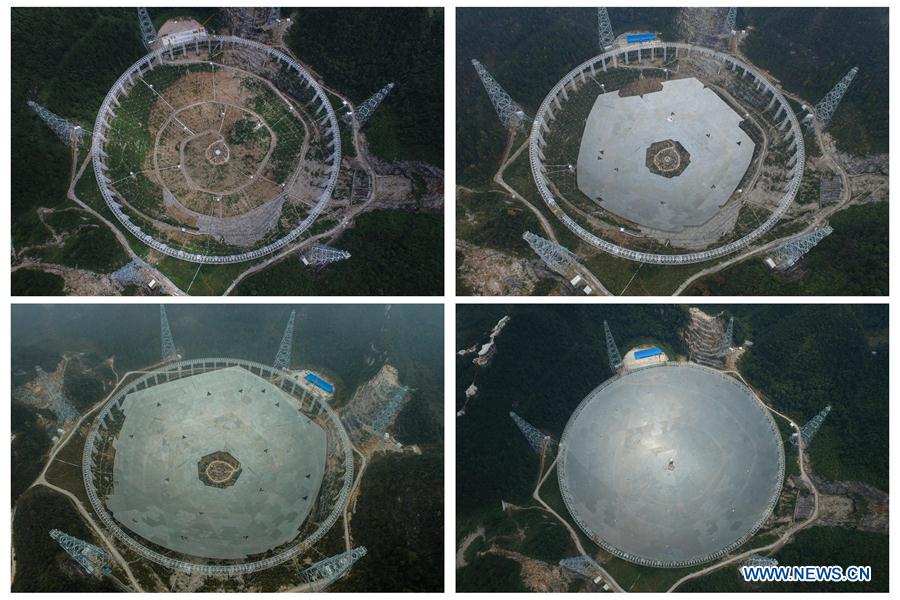JSCh
ELITE MEMBER

- Joined
- Jun 9, 2011
- Messages
- 13,235
- Reaction score
- 2
- Country
- Location
China Assembles World's Largest Telescope in Guizhou---Chinese Academy of Sciences
Jul 24, 2015

Photo taken on July 16 2014 shows the construction site of the world's largest radio telescope deep in the mountains of southwest China's Guizhou Province. (Photo/Xinhua)
Technicians have begun assembling the world's largest radio telescope, with a dish the size of 30 football grounds, deep in the mountains of southwest China's Guizhou Province.
Yesterday afternoon, they began to assemble the telescope's reflector, which is 500 meters in diameter and made up of 4,450 panels. Each panel is an equilateral triangle with sides 11 meters long.
Once complete, the single-aperture spherical telescope called FAST will be the world's largest, exceeding the one at Puerto Rico's Arecibo Observatory, which is 300 meters in diameter.
Nan Rendong, chief scientist of the FAST project with the National Astronomical Observatory, Chinese Academy of Sciences, told reporters the bigger dish will be able to pick up weaker signals.
"A radio telescope is like a sensitive ear, listening to tell meaningful radio messages from white noise in the universe. It is like identifying the sound of cicadas in a thunderstorm," he said.
The giant dish is being built on a naturally formed bowl-like valley. "There are three hills about 500 meters away from one another, creating a valley that is perfect to support the telescope," said Sun Caihong, FAST's chief engineer.
The karst formation in the local landscape is good for draining rainwater underground and protecting the reflector, Sun said.
The surrounding area has "radio silence" as there are no towns and cities within a 5-kilometer radius and only one county center within 25 kilometers.
The huge dish is hung over the ground supported by thousands of steel pillars and cables.
A hill-top observation platform is under construction and will be open to the public, Sun said.
Wu Xiangping, director-general of the Chinese Astronomical Society, said that for years scientists had to work with "second hand" data collected by others.
"Having a more sensitive telescope, we can receive weaker and more distant radio messages. It will help us to search for intelligent life outside of the galaxy and explore the origins of the universe," Wu said. (Xinhua)

Jul 24, 2015

Photo taken on July 16 2014 shows the construction site of the world's largest radio telescope deep in the mountains of southwest China's Guizhou Province. (Photo/Xinhua)
Technicians have begun assembling the world's largest radio telescope, with a dish the size of 30 football grounds, deep in the mountains of southwest China's Guizhou Province.
Yesterday afternoon, they began to assemble the telescope's reflector, which is 500 meters in diameter and made up of 4,450 panels. Each panel is an equilateral triangle with sides 11 meters long.
Once complete, the single-aperture spherical telescope called FAST will be the world's largest, exceeding the one at Puerto Rico's Arecibo Observatory, which is 300 meters in diameter.
Nan Rendong, chief scientist of the FAST project with the National Astronomical Observatory, Chinese Academy of Sciences, told reporters the bigger dish will be able to pick up weaker signals.
"A radio telescope is like a sensitive ear, listening to tell meaningful radio messages from white noise in the universe. It is like identifying the sound of cicadas in a thunderstorm," he said.
The giant dish is being built on a naturally formed bowl-like valley. "There are three hills about 500 meters away from one another, creating a valley that is perfect to support the telescope," said Sun Caihong, FAST's chief engineer.
The karst formation in the local landscape is good for draining rainwater underground and protecting the reflector, Sun said.
The surrounding area has "radio silence" as there are no towns and cities within a 5-kilometer radius and only one county center within 25 kilometers.
The huge dish is hung over the ground supported by thousands of steel pillars and cables.
A hill-top observation platform is under construction and will be open to the public, Sun said.
Wu Xiangping, director-general of the Chinese Astronomical Society, said that for years scientists had to work with "second hand" data collected by others.
"Having a more sensitive telescope, we can receive weaker and more distant radio messages. It will help us to search for intelligent life outside of the galaxy and explore the origins of the universe," Wu said. (Xinhua)

























